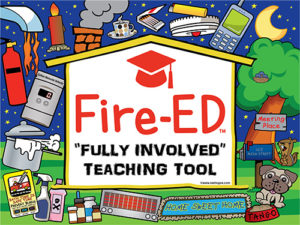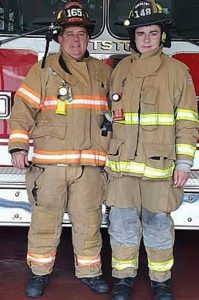By: Robert Avsec, Executive Fire Officer
If you’re one of the millions of parents who think that someone else is teaching your child how to avoid becoming a victim of fire here are a couple of “inconvenient truths”:
Truth 
The majority of fire departments in the U.S. and Canada “suck” when it comes to delivering fire and life safety education and training to their citizens, particularly children. I say that without malice as a retired fire department battalion chief who served the community of Chesterfield County (Va.) for 26-years. The reality is that reduced funding and increased demand for emergency service responses force many fire departments to fund those activities; it’s the “squeaky wheel gets the oil” syndrome at work.
The average career-staffed fire department spends less than one percent of its operating budget on fire prevention activities. Out of that paltry sum, the money gets shared between three separate fire prevention tasks: (1) fire code inspections and enforcement; (2) fire and arson investigations; and (3) fire and life safety education programs.
The situation is even more dire in communities served by smaller career-staffed departments and volunteer-staffed departments. Many of those fire departments have no fire and life safety education programs at all.
Truth 
Firefighters don’t become firefighters to teach fire and life safety education programs. From Day #1 of their training (in most departments) that training focuses on the knowledge, skills, and abilities necessary to become a safe, effective, and efficient firefighter. Not an educator.
That’s because they’re becoming part of a culture that has always focused on putting out fires, not preventing them. It also goes back to fact that there’s only so much money and time to go around and therefore their training focuses on the immediate and pressing need: Firefighters to respond to fires and other emergencies.
Before I go on, let me clarify that giving school-aged children tours of fire stations, showing them what their teacher looks liked when dressed in a firefighter’s gear, and giving out plastic fire helmets and Junior Fire Marshal stickers are not fire and life safety education. None of those activities, and others like teaching “stop-drop-and-roll” actually teach children how to avoid becoming a victim of fire.
Truth 
The school your child attends has neither the resources or the time to teach your child fire safety behaviors. School systems in the U.S. and Canada face the same fiscal pressures as fire department to “do more with less.” Teachers and administrators are tasked with complying with increasing federal and state/provincial requirements and standards. They are also on the “front-lines” as quasi-social workers faced with too many children who come to school hungry, abused, or lacking parental guidance. Oh, and they teach your children.
There’s a Better Way Forward
If you accept these truths, then you should realize that the current way of doing things is not going to get better. Fire  departments and school systems are never going to have the resources (time, money, and people) to conduct effective and efficient fire and life safety education programs for children. And certainly not on the scale necessary to reach every child in a community multiple times during their developmental years.
departments and school systems are never going to have the resources (time, money, and people) to conduct effective and efficient fire and life safety education programs for children. And certainly not on the scale necessary to reach every child in a community multiple times during their developmental years.
But there is a better way: FireED Community and social entrepreneurship. Together, these can become the foundation for a strong and vibrant fire and life safety education program in any sized community.
Social entrepreneurship is about starting local movements that grow exponentially to solve massive social problems. Fire deaths and accidents are preventable, and yet they claim far too many lives each year. In 2016 there were almost half a million burn injuries in the U.S. and almost three thousand fatalities due to preventable home fires. The fact that so many of these could be avoided with fire and life safety education is stunning. And a prime example of a “massive social problem” that lends itself to a social entrepreneurship solution.
Social entrepreneurship in action

Social entrepreneurs, Joe and Brendan Kelly, are bringing real fire and life safety education to children using the Fire-ED Interactive Teaching System. How are children in your community learning how to avoid becoming a victim of fire? Are they?
Joe Kelly and his son, Brendan, have found a model that works through becoming involved with the Fire-ED Interactive Community for Eliminating Preventable Fires. Joe is a 33-year firefighter with the Pittston (Pa.) Fire Department and Brendan is a Junior Firefighter with the same department following in his dad’s footsteps.
With the Fire-ED Fully Involved Teaching Tool, Joe and Brendan are empowering the children in their community—and others in Pennsylvania—to become role models in their community as they help their peers identify and eliminate fire hazards in their homes. What makes this resource stand out is that it is new, it’s interactive, engaging for the kids and, most importantly, based on the industry’s best practices for teaching fire and life safety education.
But what really makes Joe and Brendan “paradigm changers” is that it’s the Fire-ED Interactive Teaching System that’s the “star of the show.” Sure, Joe’s experience and passion for fire and life safety education enhance the experience of the children, but the Fire-ED system is a tool that can be used by anyone in a community who has the desire and energy to become a social entrepreneur and tackle the social problem of fire-related deaths, injuries and property loss.
And the system is scalable. Individuals like Joe and Brendan can get behind it and so can a pretty good-sized company like Firefox Solutions, a leading vendor for fire apparatus and firefighting equipment based in Edmonton, Alberta. Firefox, and its President, Wayne Wald, have collaborated with Fire-ED Interactive to deliver a presentation to fire service and civic leaders in Edmonton and the surrounding areas to show them how the combination of Fire-ED Interactive and social entrepreneurship are the “game changer” when it comes to fire and life safety education delivery.
To learn more about Fire-ED Interactive, and how you can become a member of the Fire-ED Interactive Community On-line, go to FireED Community today!
 Fire & EMS Leader Pro The job of old firefighters is to teach young firefighters how to become old firefighters!
Fire & EMS Leader Pro The job of old firefighters is to teach young firefighters how to become old firefighters!